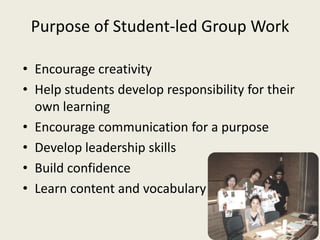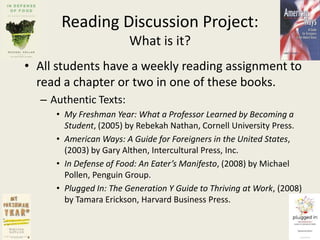Creating student led content-based group projects
- 1. Creating Student-LedContent-Based Group ProjectsBy Robin RogersUniversity of OregonAmerican English Institute
- 2. Purpose of Student-led Group WorkEncourage creativityHelp students develop responsibility for their own learningEncourage communication for a purposeDevelop leadership skillsBuild confidenceLearn content and vocabulary
- 3. Reading Discussion Project:What is it?All students have a weekly reading assignment to read a chapter or two in one of these books.Authentic Texts:My Freshman Year: What a Professor Learned by Becoming a Student, (2005) by Rebekah Nathan, Cornell University Press.American Ways: A Guide for Foreigners in the United States, (2003) by Gary Althen, Intercultural Press, Inc.In Defense of Food: An Eater’s Manifesto, (2008) by Michael Pollen, Penguin Group.Plugged In: The Generation Y Guide to Thriving at Work, (2008) by Tamara Erickson, Harvard Business Press.
- 4. Reading Discussion Project:What is it?Vocabulary Lists:Word Lists with 25 Academic Word List words that appear in that week’s reading are given to students at the beginning of each week as a study guide.
- 5. Reading Discussion Project:Students sign up for these roles at the beginning of the term.They know which week they will be the leader.Discussion Leader (3-5 leaders/week)Prepares discussion questions about the weekly reading assignments.Leads a small group of their classmates in a discussion Vocabulary Leader (2-4 leaders/week)Creates a vocabulary review activity Helps students review the part of speech, synonyms, definitions and spelling of the words
- 6. Teamwork
- 7. Discussion Leaders: Before the DiscussionRead the assigned reading.Student leaders meet with other group members to create 6-10 discussion questions about the main ideas of the chapter.One member of the group sends the questions to the teacher to check grammar and clarity.Teacher meets with the students to give comments and possible corrections.Students make corrections and send them back to the teacher.Teacher posts electronic copy of the questions for the class to use to prepare answers for discussion.
- 8. Example of Student-Created Questions
- 9. Vocabulary Leaders:Before the Review ActivityFind the definitions and parts of speech for the 25 vocabulary words for their week.Get together with their group to plan.Share their ideas for activities with the teacher before the day of the review.Tell the teacher if any materials are needed.Prepare materials and Rules/Roles for the Activity.
- 11. Learning through the process: Developing Leadership SkillsEach Vocabulary Leader should have a role:Speaker: Giver of directionsCommunicate ClearlySet goals and rules for activityKnow how to pronounce the words or questionsMaterial Maker: Create and organize your materials and ideasMediator, Score keeper and/or Time Keeper*Part of being a good leader is listening to your classmates.
- 12. Teachers’ Role: Encourage CreativityGive clear directionsModel the activityHave fun and be creativeSet up the structure by:Creating unityOffering safety and stability through organizationHaving a consistent schedule and routineHaving set roles for participants
- 13. Students’ Roles: Prepare and lead All Students responsibilities:Learn vocabulary and prepare answers to questions Work as a team in and out of classCompromise and negotiate Balance tasks and create materialsDevelop communication skillsImprove pronunciation and clarityManage time of activity
- 14. PlanningMake clear students’ roles in the groupSet up meeting times with the teacher prior to class presentationTeacher plays a support role and helps clarify directions with the students
- 15. Things for students to consider when planning:When are you going to meet and plan?What ideas and questions can you contribute?Did you listen to others’ ideas also?Who is going to prepare materials?Who is going to explain the rules?Are you going to keep score and/or help your classmates?
- 16. Evaluating Group WorkStudents can reflect on their own learning.Grades are given based on:Correct use of grammar and vocabularyPreparation/ On time/ OrganizationInvolvement in the activityUse of timeClarity of Instructions Collaboration and Teamwork
- 19. Learning through the process: Building ConfidenceReading Discussion Project Allows Students To:Take risksTry something newInteract with the materialInteract with the classmatesDevelop their English voiceShare opinions in the discussionSpeak English in a safe environment
- 20. Conclusion:Even though group work takes a lot of time to set up, it can be very rewarding and can lead to some great results.Students’ comments are always positive about this project.If the teachers are willing to take risks and time to set it up, this project can be challenging and rewarding.



















